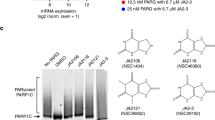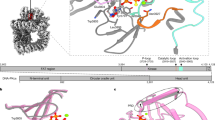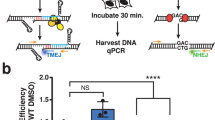Abstract
DNA-dependent protein kinase (DNA-PK) and poly (ADP-ribose) polymerase-1 (PARP-1) participate in nonhomologous end joining and base excision repair, respectively, and are key determinants of radio- and chemo-resistance. Both PARP-1 and DNA-PK have been identified as therapeutic targets for anticancer drug development. Here we investigate the effects of specific inhibitors on enzyme activities and DNA double-strand break (DSB) repair. The enzyme activities were investigated using purified enzymes and in permeabilized cells. Inhibition, or loss of activity, was compared using potent inhibitors of DNA-PK (NU7026) and PARP-1 (AG14361), and cell lines proficient or deficient for DNA-PK or PARP-1. Inactive DNA-PK suppressed the activity of PARP-1 and vice versa. This was not the consequence of simple substrate competition, since DNA ends were provided in excess. The inhibitory effect of DNA-PK on PARP activity was confirmed in permeabilized cells. Both inhibitors prevented ionizing radiation-induced DSB repair, but only AG14361 prevented single-strand break repair. An increase in DSB levels caused by inhibition of PARP-1 was shown to be caused by a decrease in DSB repair, and not by the formation of additional DSBs. These data point to combined inhibition of PARP-1 and DNA-PK as a powerful strategy for tumor radiosensitization.
This is a preview of subscription content, access via your institution
Access options
Subscribe to this journal
Receive 50 print issues and online access
$259.00 per year
only $5.18 per issue
Buy this article
- Purchase on Springer Link
- Instant access to full article PDF
Prices may be subject to local taxes which are calculated during checkout





Similar content being viewed by others
References
Ariumi Y, Masutani M, Copeland TD, Mimori T, Sugimura T, Shimotohno K, Ueda K, Hatanaka M and Noda M . (1999). Oncogene, 18, 4616–4625.
Benjamin RC and Gill DM . (1980). J. Biol. Chem., 255, 10502–10508.
Blunt T, Finnie NJ, Taccioli GE, Smith GC, Demengeot J, Gottlieb TM, Mizuta R, Varghese AJ, Alt FW, Jeggo PA and Jackson SP . (1995). Cell, 80, 813–823.
Boulton S, Kyle S and Durkacz BW . (1999). Carcinogenesis, 20, 199–203.
Boulton S, Kyle S, Yalçintepe L and Durkacz BW . (1996). Carcinogenesis, 17, 2285–2290.
Bradley MO and Kohn KW . (1979). Nucleic Acids Res., 7, 793–804.
Calsou P, Frit P, Humbert O, Muller C, Chen DJ and Salles B . (1999). J. Biol. Chem., 274, 7848–7856.
de Murcia G and Menissier de Murcia J . (1994). Trends Biochem. Sci., 19, 172–176.
DiBiase SJ, Zeng ZC, Chen R, Hyslop T, Curran Jr WJ and Iliakis G . (2000). Cancer Res., 60, 1245–1253.
D'Silva I, Pelletier JD, Lagueux J, D'Amours D, Chaudhy MA, Weinfeld M, Lees-Miller SP and Poirier GG . (1999). Biochim. Biophys. Acta, 1430, 119–126.
Finnie NJ, Gottlieb TM, Blunt T, Jeggo PA and Jackson SP . (1995). Proc. Natl. Acad. Sci. USA, 92, 320–324.
Fornace Jr AJ and Little JB . (1977). Biochim. Biophys. Acta, 477, 343–355.
Galande S and Kohwi-Shigematsu T . (1999). J. Biol. Chem., 274, 20521–20528.
Gottlieb TM and Jackson SP . (1993). Cell, 72, 131–142.
Halldorsson H, Gray DA and Shall S . (1978). FEBS Lett., 85, 349–352.
Izzard RA, Jackson SP and Smith GCM . (1999). Cancer Res., 59, 2581–2586.
Jackson SP . (1997). Int. J. Biochem. Cell. Biol., 29, 935–938.
Jeggo PA . (1997). Mutat. Res., 384, 1–14.
Kemp LM, Sedgewick SG and Kemp PA . (1984). Mutat. Res., 132, 189–196.
Kim C-H, Park S-J and Lee S-H . (2002). J. Pharmacol. Exp. Ther., 303, 753–759.
Kohn KW, Ewig RAG, Erickson LC and Zwelling LA . (1981). DNA Repair: A Laboratory Manual of Research Procedures, Vol. 2, Part B, Friedberg EC and Hanawalt PC (eds). Marcel-Dekker: New York and Basel, pp 379–401.
Li B, Navarro S, Kasahara N and Comai L . (2004). J. Biol. Chem., 279, 13659–13667.
Lindahl T, Masahiko S, Satoh G, Poirier G and Klungland A . (1995). TIBS, 20, 405–411.
Menissier de Murcia J, Niedergang C, Trucco C, Ricoul M, Walztinger C, Mark M, Olivier FJ, Masson M, Dierich A, LeMeur M, Dutrillaux B, Chambon P and de Murcia G . (1997). Proc. Natl. Acad. Sci. USA, 94, 7303–7309.
Merkle D, Douglas P, Moorhead GB, Leonenko Z, Yu Y, Cramb D, Bazett-Jones DP and Lees-Miller SP . (2002). Biochemistry, 41, 12706–12714.
Omori S, Takiguchi Y, Suda A, Sugimoto T, Miyazawa H, Takiguchi Y, Tanabe N, Tatsumi K, Kimura H, Pardington PE, Chen F, Chen DJ and Kuriyama T . (2002). DNA Repair, 1, 299–310.
Pannicke MY, Schwarz K and Lieber MR . (2002). Cell, 108, 781–794.
Peng Y, Zhang Q, Nagasawa H, Okasayu R, Liber HL and Bedford JS . (2002). Cancer Res., 62, 6400–6404.
Pleschke JM, Kleczkowska HE, Strohm M and Althaus FR . (2000). J Biol. Chem., 275, 40974–40980.
Rudat V, Bachmann N, Kupper JH and Weber KJ . (2001). Int. J. Radiat. Biol., 77, 303–307.
Ruscetti T, Lehnert BE, Halbrook J, Trong HL, Hoekstra MF, Chen DJ and Peterson SR . (1998). J. Biol. Chem., 273, 14461–14467.
Sak A, Stuschke M, Wurm R, Schoeder G, Sinn B, Wolf G and Budach V . (2002). Cancer Res., 62, 6621–6624.
Satoh MS and Lindahl T . (1992). Nature, 356, 356–358.
Schreiber V, Ame JC, Dolle P, Schultz I, Rinaldi B, Fraulob V, Menissier de Murcia J and de Murcia G . (2002). J. Biol. Chem., 277, 23028–23036.
Schultz N, Lopez E, Saleh-Gohari N and Helleday T . (2003). Nucleic Acids Res., 31, 4959–4964.
Singleton BK, Priestly A, Gell T, Blunt T, Jackson SP, Lehmann AR and Jeggo PA . (1997). Mol. Cell. Biol., 17, 1264–1273.
Skalitzky DJ, Marakovits JT, Maegley KA, Ekker A, Yu XH, Hostomsky Z, Webber SE, Eastman BW, Almassy R, Li J, Curtin NJ, Newell DR, Calvert AH, Griffin RJ and Golding BT . (2003). J. Med. Chem., 46, 210–213.
Smith GC and Jackson SP . (1999). Genes Dev., 13, 834–916.
Smith S . (2001). TIBS, 26, 174–179.
Smulson ME, Pang D, Jung M, Dimtchev A, Chasovskikh S, Spoonde A, Simbulan-Rosenthal C, Rosenthal D, Yakovlev A and Dritschilo A . (1998). Cancer Res., 58, 3495–3498.
Susse S, Scholz CJ, Burkle A and Wiesmuller L . (2004). Nucleic Acids Res., 32, 680–699.
Tentori L, Partarena I and Graziani G . (2002). Pharmacol. Res., 45, 73–85.
Veuger SJ, Curtin NJ, Richardson CJ, Smith GCM and Durkacz BW . (2003). Cancer Res., 63, 6008–6015.
Ward JF . (1988). Prog. Nucleic Acid Res. Mol. Biol., 35, 95–125.
Yang Y-G, Cortes U, Patnaik S, Jasin M and Wang Z-Q . (2004). Oncogene, 23, 3872–3882.
Acknowledgements
This work was supported by funds from the Cancer Research UK. AG14361 was kindly provided by Pfizer GRD, San Diego, California.
Author information
Authors and Affiliations
Corresponding author
Rights and permissions
About this article
Cite this article
Veuger, S., Curtin, N., Smith, G. et al. Effects of novel inhibitors of poly(ADP-ribose) polymerase-1 and the DNA-dependent protein kinase on enzyme activities and DNA repair. Oncogene 23, 7322–7329 (2004). https://doi.org/10.1038/sj.onc.1207984
Received:
Revised:
Accepted:
Published:
Issue Date:
DOI: https://doi.org/10.1038/sj.onc.1207984
Keywords
This article is cited by
-
DNA repair kinetics in SCID mice Sertoli cells and DNA-PKcs-deficient mouse embryonic fibroblasts
Chromosoma (2017)
-
Assessment of PARP protein expression in epithelial ovarian cancer by ELISA pharmacodynamic assay and immunohistochemistry
Tumor Biology (2016)
-
Predictive biomarkers for cancer therapy with PARP inhibitors
Oncogene (2014)
-
DNA-PK inhibition by NU7441 sensitizes breast cancer cells to ionizing radiation and doxorubicin
Breast Cancer Research and Treatment (2014)
-
PARP1 and DNA-PKcs synergize to suppress p53 mutation and telomere fusions during T-lineage lymphomagenesis
Oncogene (2013)



